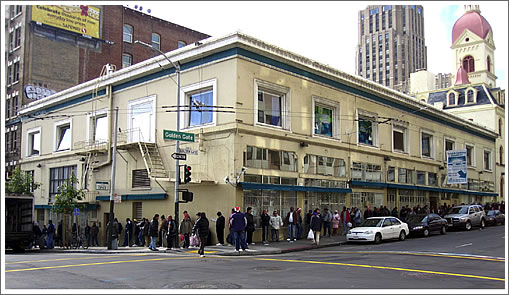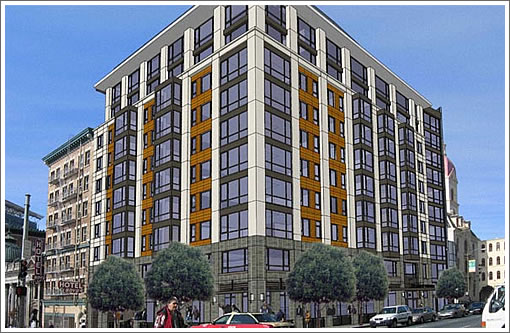
The St. Anthony Foundation will serve their last lunch from the basement of the two-story building at 121 Golden Gate Avenue today, will serve to-go meals tomorrow and Friday, and will move across the street to a temporary dining room for two years while a new ten-story building with 90 senior housing units over a ground floor dining hall rises.

∙ Designs For Building Senior Housing At 121 Golden Gate Avenue [SocketSite]
∙ An Alternative To Preserve The Past At 121 Golden Gate Avenue [SocketSite]

We only have 9 stories worth of seniors needing housing?
They’d get more bangs for their bucks by cashing out by selling the land to a private developer and building this building in the EB.
I’m sure everyone in that photo would love to commute to the east bay.
How much is the envelope of an SF building like this.
A wild guesstimate:
How much would it cost ti build, including land? 15M? 20M? 25M? Save a lot by building it in an area where building costs are 25% less and land is much cheaper, and you save in the range of 5M. Probably much more.
Take these 5M and divide them by 90 seniors. That’s 50K+/pop (pun intended). You can allocate the money to provide the healthcare costs for these seniors for a few years.
Of course it would be cruel to do that, right?
Well you would be providing the service for different people.
Why do you think building is 25% less in the east bay? Material is the exact same, wages are set, the exact same companies would bid the work.
The land is cheaper, okay. They have to buy and sell what they have so that will eat into profit. Plus they would have to start the whole design and permit process after selling and then buying a place in the EB. So they would have been out of commission for a much longer time.
This is low income, senior housing. There are probably subsidies as well.
SF and the EB are similar in terms of cost? Same union constraints? Same endless hoops to go through? I am sure a city in need of new business will be very happy to ease that for you.
What I am simply saying is that for $1 of donation money there are ways to get better bangs for your bucks. If the issue is “if you build it out there they won’t come” then I don’t know what the problem is. If people prefer to be homeless than living 20 miles away in decent housing, then we should stop being so accommodating because we are becoming the butt of the joke in all of this.
There is no stopping anyone pricing work in the EB and SF, in fact that is what happens all the time. Insurance, Workers Comp., etc. are not local costs.
The endless hoops are done when construction starts. They are past that point for this project. But if they sold here and bought in the EB they would start all over.
Could a city smooth the way and make it easier to start, yes. Like say having the Mayors office of housing create a $26M mortgage bond for construction. Plus another city smoothing the way doesn’t start until the architect is done. There would be years of lost time.
This is also next door to a bunch of other Mercy Housing services. And it’s not just the 90 units but the dining area as well.
I suspect the organization that builds it has a charter that was set by its original donors. The charter sets forth the boundaries of their service area and that is likely to be SF.
I sort of vaguely recall a situation years ago where a woman had a will that specified that her estate was to be used to set up a charitable foundation to help homeless people in Marin. By the time she died, the assets in her estate were so large that there was enough to give every homeless person in Marin some huge amount of money. In that case, the foundation had to go to court and get the court to broaden the scope of the foundation. I recall it not being easy to do, but the amount was so ridiculously high (like $500,000 for every homeless person in Marin County) that the judge finally agreed to it. I think he agreed to allow it to be used to help other people, but they still had to be in Marin because that would have been her wish had she realized what had happened.
So if the charter says SF, it’s SF. It doesn’t matter that there are more efficient ways of dealing with it. That’s their role.
^ that was the Buck Foundation.
I just read this thread. What a silly conversation. St. Anthony’s Foundation is based in San Francisco to serve the needy in San Francisco…they aren’t about to move to the east bay just because development costs are lower. Doubtless they have used both their SF donor base AND City affordable housing funds to make this project pencil out. Kudos to them….not easy to do.
curmudgeon, it depends on their charter. If the charter is that they serve the bay area, they’d be in the east bay in a heartbeat.
The great thing about this site is that it allows lots of us to educate each other. Futurist notices double hung windows have been replaced on a different property when none of us would have noticed, for example. It’s good for someone to question something, if they don’t know the answer.
There are two contributing factors to non-profit affordable housing being expensive. First, THE major cost of any project is the cost of money. Look at the construction signs on any affordable housing construction project and you will see a list of 6 to 8 to 10 lenders. These deals are very time consuming and expensive and hard to put together – much more so than for market rate projects. (And these costs would be the same in the EB or SF or anywhere else.) Secondly, in addition to all the community interior and exterior space typically provided, these projects will be owned forever by the non-profit owner. Therefore they are built to last, and often at much higher standards than the spec developer who will only own the condos a few months until sold, and then maintenance becomes the buyers’ problem.
I doubt most or even many of the seniors drive. As such, I’m sure they appreciate being able to walk to Bart, or the main library, or the shopping mall, to say nothing of cafes and other small businesses. That’s not something that is necessarily going to be possible at a generic East Bay location. Would you pay $50,000 to avoid being trapped with few places to go? I think many would.
Now obviously crime is a concern, but in constructing a building like this you have to look to future decades, when the situation may be different. Apart from crime problems, I think this is a fantastic location for senior housing.
Now obviously crime is a concern, but in constructing a building like this you have to look to future decades, when the situation may be different.
Not to rain on your parade, but does fixating the quasi-homeless in this location go counter to making things different? By adding homeless housing capacity we’re essentially freeing up beds from shelters that will be taken over in a snap, in short making the area even more attractive to the homeless.
But the dire unintended consequences will come down the road, probably 10 to 20 years. Then we’ll all be appalled by the overwhelming misery and we’ll have to continuously mitigate again, stuck in a never ending losing spiral and pushing away tough choices over and over again.
In short, homeless foundations are “top 1%” funded entities shoving down the “bottom 1%” problem THEY created into the remaining 98%’s throats.
And we all have to feel guilty about it. By design.
The dire unintended consequences of a charity housing a bunch of old people?
Look, I get that policies have to be sustainable, and that San Francisco can’t take care of every homeless person who shows up, and that any solution will have to be national.
But you seem to be working under the assumption that this is some sort of warehousing operation for derelicts, and that one may as well dump them somewhere far away in the cheapest possible location. I doubt the people at St. Anthony’s feel that way.
I’m pretty sure that the majority of the people who benefit from their services aren’t shitting on the streets, cursing at tourists, or abusing heroin. I’m all for cracking down on quality-of-life crimes. And, yeah, people convicted of antisocial crimes should not be given housing here– not because they need to be punished, but because it hurts the other residents, which is indeed counterproductive.